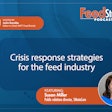
What human health findings teach about animal microbiomes (18:51)
Ann Reus: Hello and welcome to the Feed Strategy podcast. I’m your host, Feed Strategy senior reporter Ann Reus.
Have you ever wondered how we’ve come to learn so much about gut health and the microbiome of animals? Dr. Steve Lerner is senior scientific and business adviser at Chr. Hansen, and he’s here to talk about how discoveries in human health have contributed to improvements in the microbiome of poultry and livestock.
Hi, Steve, thanks for being here with me today.
Steve Lerner: Hi, Ann. Very happy to be here.
Reus: The microbiome has gained a lot of popularity lately. Why do you think there has been such a focus on the microbiome in recent years?
Lerner: I believe people’s understanding of microbiology has improved amazingly, in the last, say, four or five decades. Thirty, 40 years ago, the general rule was kill germs, disinfection, and many products came to the market, hand sanitizers, bleach wipes. And then, basically, from human health professionals, we learned that the bacteria that populate our digestive system and our skin can actually be quite beneficial and helpful. And you began to see probiotics being offered in yogurts, you began to see people talking about gut health, and the management of bacteria. And then microbiologists stepped up to the plate and began to find ways to describe to our populace, our customers, what was actually going on. And they coined terms like microbiota. It used to be called gut flora. They began looking at the genetics and coined microbiome. And now these words have become common tools for communication from your physician, other health care professionals, and of course, in the suppliers of additives for foods and for feeds.
Reus: How do you identify an unhealthy microbiome and then how do you improve that gut health?
Lerner: Some of the earliest work on unhealthy microbiomes comes again from human medicine. There is a problem that occurs in geriatric patients where they can be overcome by an infection of Clostridia, it’s called Clostridium difficile. It causes horrible diarrhea, and can actually be a condition that results in mortality. One of the best drugs to fight this is rifampin, but it has its own problems. So a very clever physician said, well, perhaps, if we can transfer the microbiome from a healthy individual into a sick patient, then perhaps we can restore normalcy. So they began taking a sample of fecal material and injected it into the duodenum, just below the stomach, the beginning of the intestinal tract. And with a 95% success rate, they began to cure this Clostridium difficile infection and it opened the door for trying to assess what was going on to cause problems, a bad microbiome, and how to restore normal, good, microbiomes and the entire field of science was born. There are many tools available to scientists to assess the genetics that are present in the bacterial population in the guts of people and in animals. The science is about 20 years old, and is blossoming because of the investments being made because we’re finding that proper management of the microbiome, keeping it in a healthy state, if you will, has tremendous benefits in health and longevity.
Reus: How does the microbiome affect other systems in the body?
Lerner: There is beautiful evidence that what the microbiome does – a healthy, robust, beneficially balanced microbiome – takes fibers that are in our diet and it digests these fibers into a class of molecules called short-chain fatty acids. You may have heard of some of these, they’re acetate and butyrate and propriate. And these things are produced in a relatively high concentration by good bacteria in the gut. And these molecules, these short-chain fatty acids, are received by different cells that line our intestinal tract. Some create direct nervous signals that are carried by the vagus nerve to our brains. Other cells send out hormonal signals, like serotonin, or peptide YY, or gamma aminobutyric acid. These are chemical agents that act throughout the body. Other cells stimulate immune responses, and all of these things start with the digestion of these fibers by good bacteria.
What’s known is that the general biological reaction in animals is positive. It reduces peripheral inflammation, it causes the hormones of well-being like serotonin to be secreted and released in the brain. It actually, these short-chain fatty acids can cross into the brain across the blood-brain barrier, and have positive actions in our brains. We also know that our brains have signals that go down to our gut. If you want to believe me, you’ve ever been scared enough, bad enough, you know that there’s an immediate action your brain sends to your gut, and you have a reaction that’s demonstrable. But this closed system, this feedback from the gut to the brain, the brain back to the gut, and the gut to the microbiome is now been coined as the gut-brain-microbiome axis. And if you have a healthy microbiome, this is a positive impact in that system.
However, any disruption any perturbation, any illness can not only change the microbiome towards a deleterious condition, but that will have consequences. It could affect the spectrum of autism, it could affect your capacity to develop Type 1 diabetes, it could cause some things like gingivitis. It’s amazing that if you alter in a negative way, the microbiome, the extent of the physiologic problems that can develop. On the contrast, if you maintain a good, healthy microbiome, then there are health benefits to be had.
Reus: What is the Anna Karenina principle and how does it relate to the microbiome of poultry?
Lerner: Anna Karenina is a book written by Leo Tolstoy in 1893. I was just a small child at that time. And Leo made a quote that said all healthy families are alike, but each unhealthy family is unhealthy in its own way. A clever microbiologist Jesse, Zaneveld and others, turn that into, “all healthy microbiomes are alike. Each unhealthy microbiome is unhealthy in its own way.”
And the way we assess the health of a microbiome is to look at the alpha diversity, the number and evenness of distribution of microorganisms in an individual. And then beta diversity looks at the variation among individuals. So, if you have a healthy population, each individual should have a high richness, number of bacteria and high evenness, and as a group, their microbiome should be similar. In contrast, if you have a group that is challenged, the individual variation for an individual animal should be low and the microbiomes among that group should have a high beta diversity. And that represents the Anna Karenina principle: If it’s they’re all healthy, they’re alike. If they’re unhealthy, they’re unalike.
Well, we did a study looking at the relationship between growth rate of chickens and the status of their microbiome. We took a couple hundred birds, put them in the pen for 37 days, measured a lot of things. We had a three-and-a-half pound range in the smallest to biggest bird in 37 days, which is remarkable considering the biggest bird was about six pounds. We found that the smallest 25 birds, the microbiomes in that group were very different, had a lot of diversity, and that the individual birds had a lower diversity, a lower alpha diversity index. But the biggest birds in the group, the 25 biggest, they were a bit more uniform group and their microbiomes were more similar – an example of the end of Anna Karenina principle.
The other tie back is that among the organisms that were more abundant in the big birds, which there were 31 different genera that were more abundant, all of them were known to be producers of short-chain fatty acids. So it’s very likely that the big birds were benefiting of the short-chain fatty acids being produced in their guts, they had the best capacity to do so, and we believe this was a driver of their mental and physical well-being. They felt better, they were behaving better. But the smallest birds that did not have a good capacity to produce short-chain fatty acids were probably severely challenged, not only physically, but if you will, from a cognitive standpoint, and they did not do well in that environment.
Reus: What feed additives can be used alone or in combination to improve poultry gut health?
Lerner: There is tremendous research in the literature that looks at opportunities with prebiotics, which are these fibers that you can put into diets, they’re very stable, they act really as fertilizer to improve the likelihood of success of the good bacteria that create a microbiome. There are probiotic organisms that are living, they go into an animal by definition, if you feed them in adequate quantities, they confer a health benefit on their host. And there are other feed additives like essential oils or organic acids that have been demonstrated to have a beneficial effect. My favorite, of course, and the one that I’ve had most personal experience with, are probiotics. And I like the idea of supplementing the living group of organisms in my intestinal tract with other living organisms that had been researched and demonstrated to offer very reasonably good benefits to the host animal.
Reus: Yeah, what did I hear you say the other day, you and everyone you know and love should be taking a probiotic every day?
Lerner: I believe every person and every animal in our care should be on an effective probiotic every day from Day 1. And there’s some stories that compel me to tell you this. So the first one, there’s a double-blind placebo-controlled study, looking at 192 babies with colic. These 192 babies were separated into 96 in a control group that received a placebo and 96 that received an effective probiotic. The strain of organism is a Bifidobacterium, BB-12. These babies were crying, on average, 140 plus or minus 30 minutes a day. That’s, you know, two and a half, almost three hours of crying. I’ve been with a baby on an airplane crying, it’s not a good day. And over the course of three weeks, again, in a double-blind placebo-controlled study, these babies had significantly less crying when they were on the effective probiotic. They went down to under 60 minutes a day. Interestingly, they also in this study did a pediatric quality of life score, which assesses the physical and social and emotional states of the parents. And lo and behold, those parents whose babies were crying less did better. So there’s a run-on effect.
The other study that I that I always speak about, has to do with very early preterm infants that are kept in neonatal intensive care units in their first days of life. And you know this is a very high-risk situation. And one of the conditions that these very early preterm babies are susceptible to is called necrotizing enterocolitis. And this is a condition where their intestinal tract becomes infected, sections of it can actually die and begin to slough, and of course this is incompatible with life. Chr. Hansen has been involved in two studies where these babies were fed an effective combination of probiotic organisms, a blend of three, or not. And in a study of 144 babies, those that were receiving a probiotic had a lower incidence and less severity of necrotizing enterocolitis. If you look at the data objectively, it saved the lives and pain and suffering of 11 babies in that study. And then a second study was done with 1,100 infants and they were only looking at severe necrotizing enterocolitis. And the use of this triple blend of probiotics reduced the severity by 50%. So when you think about just examples of the most at-risk individuals in our population, and that probiotics can demonstrably create a benefit, I’m a believer. And I take one every day, and I recommend that everybody else does so. I’ve got a five-year-old granddaughter that takes probiotic gummies, I’ve got a nine-month-old granddaughter that’s been on probiotic drops since her first day on the earth. And I’m a believer that this science is real, and everyone should avail themselves of these opportunities.
Reus: And people might think we’re talking an awful lot about human health, but animal scientists are taking this knowledge from human health and transferring it into animals and using that knowledge to further the health of the animals, right?
Lerner: Oh, Ann, you are 100% correct. I use these human examples because I know that your audience will relate directly. But if we just consider that we’re talking about mammals and birds in general, the thing that I appreciate about human health is their capacity to invest billions of dollars. And then we in the additive space, can leapfrog right to the best technologies, and bring them to bear for the animals in our care, whether that’s a lot of beef cattle, a herd of dairy cattle, a flow of pigs, a flock of chickens, or rafter of turkeys. And we can easily demonstrate, using good science and reasonable methodologies, that the supplementation of these animal diets with effective probiotics results in a benefit. And that benefit is best illustrated by the percentage of normal, healthy animals in any of those groups. And we like to speak about an axiom that says the greater percentage of healthy, normal animals in any herd, lot, flow or flock, then the greater the chance of a positive outcome of economic success. And not only are we supporting producers, in terms of efficiency of the production of meat, milk and eggs, but we believe efficient agriculture is sustainable agriculture. And when you can keep more of the carbon, hydrogen, oxygen and nitrogen that’s in feed in the bodies of the animals or in the products they put out for us, such as milk and eggs, then that efficiency saves those same elements from going back out into the environment as carbon dioxide or methane or nitrogen waste. And that is the hallmark of sustainability.
Reus: Well, thank you so much, Steve. This was really interesting.
Lerner: My absolute pleasure, Ann.
Reus: Dr. Lerner recently took part in a webinar presented by Feed Strategy and WATTPoultry where he spoke about some of these topics. You can watch that webinar on demand at feedstrategy.com/webinars. Thanks for listening. I’m Ann Reus for Feed Strategy.

















